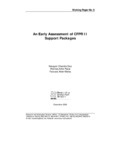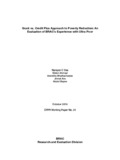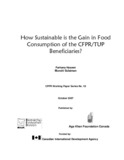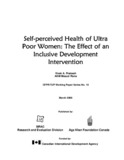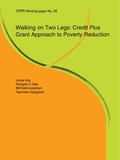Browsing by Subject "Ultra-poor"
Now showing items 1-16 of 16
-
Capability Development among the Ultra-poor in Bangladesh: A case study
(BMC, 2009-08)Microcredit is advocated as a development tool that has the potential to reduce poverty, empower participants, and improve health. Results of several studies have shown that the extreme poor, or the ultra-poor, often are ... -
Changes in extreme poverty in Bangladesh (2000–2015): Trend, dynamics, and implications for research and interventions
(Practical Action Publishing, 2018)Headcount extreme poverty in Bangladesh has been declining since 2000, but how has the profile and income distribution of the poorest changed and what do these mean for intervention design and directions for innovations? ... -
Crafting a graduation pathway for the ultra-poor: Lessons and evidence from a BRAC program
(BRAC Research and Evaluation Division, 2008-03)The ultra poor are caught in a below-subsistence trap from which it is difficult for them to break free using available resources and mechanisms. Time is not an ally for the ultra poor, as things generally do not get ... -
Does wealth increase affect school enrolment in ultra-poor households: Evidence from an experiment in Bangladesh
(Practical Action Publishing, 2015-06)Access to education is usually found to be highly correlated with household income and wealth. This correlation often instigates an expectation that increasing income of the poor households will lead to greater human capital ... -
An early assessment of CFPR II support packages
(BRAC Research and Evaluation Division, 2009-12)Based on the programmatic lessons and research knowledge accumulated from CFPR phase I, CFPR phase II was designed to expand its outreach while incorporating greater diversity in support packages. The support packages of ... -
A good mix against ultra-poverty? Evidence from a Randomized Controlled Trial (RCT) in Bangladesh
(Wiley Online Library, 2021-07-13)Published in the Review of Developmental Economics, the existing evidence from the article shows that programs that provide grants to productive assets along with training to very poor women increase labor supply, earnings, ... -
A good mix against ultra-poverty? Evidence from a Randomized Controlled Trial (RCT) in Bangladesh
(Wiley, 2021-07-13)Existing evidence shows that programs that provide grants to productive assets along with training to very poor women increase labor supply, earnings, and consumption. In contrast, evidence on the effect of microcredit on ... -
Grant vs. credit plus approach to poverty reduction: An evaluation of BRAC’s experience with ultra poor
(BRAC Research and Evaluation Division, 2016-10)Challenging the Frontiers of Poverty Reduction- Targeting the Ultra Poor (CFPR-TUP) program of BRAC implements two interventions for the ultra-poor: a grant-based support package for specially targeted ultra-poor (henceforth ... -
How sustainable is the gain in food consumption of the CFPR/TUP beneficiaries?
(BRAC Research and Evaluation Division and Aga Khan Foundation Canada, 2007-10)Despite some remarkable improvements in nutritional status, malnutrition in Bangladesh is still highly prevalent, especially among the poorest. A number of initiatives are taking place that address the food intake of the ... -
The impact of livestock asset transfers on the livelihoods of the ultra-poor
(Taylor and Francis, 2022-02-22)This paper estimates the impacts of Livestock Asset Transfers on the livelihoods of the ultra-poor in West Bengal, India. The programme provides the female members of ultra-poor households with livestock assets as grants. ... -
Influence of gender roles and rising food prices on poor, pregnant women's eating and food provisioning practices in Dhaka, Bangladesh
(© 2013 Reproductive Health, 2013)Background: Maternal malnutrition in Bangladesh is a persistent health issue and is the product of a number of complex factors, including adherence to food 'taboos' and a patriarchal gender order that limits women's mobility ... -
Pathways out of ultra-poverty: A mixed methods assessment of layered interventions in coastal Bangladesh
(Chronic Poverty Advisory Network, 2022-07)Studies suggest impoverishment in Bangladesh has been driven by climate-change-related shocks, ill-health and healthcare expenses, poor access to agricultural markets and services, and more recently, the COVID-19 pandemic. ... -
Self-perceived health of ultra poor women: The effect of an inclusive development intervention
(BRAC Research and Evaluation Division and Aga Khan Foundation Canada, 2006-03)In 2002, BRAC launched a targeted and comprehensive development program called Challenging the Frontiers of Poverty Reduction: Targeting the Ultra Poor (CFPR/TUP) aimed at the poorest of the poor, who have often been ... -
Sustaining escapes from ultra-poverty: A mixed methods assessment of layered interventions in coastal Bangladesh
(Chronic Poverty Advisory Network, 2022-07)Bangladesh’s impoverishment is driven by climate-change shocks, healthcare expenses, poor access to agricultural markets, and the COVID-19 pandemic. Ultra Poor Graduation (UPG) programme, combined with inclusive Market ... -
Ultra-poor graduation to eradicate extreme poverty in Bangladesh: a case of BRAC
(Brac University, 2019-12)Ultra-Poor Graduation programme is a programme of BRAC that works to eradicate extreme poverty. It is a two years long programme that works with selected group of people for two years and make them graduate of this programme. ... -
Walking on two legs: Credit plus grant approach to poverty reduction
(BRAC Research and Evaluation Division, 2017)There is a growing recognition that the ultra-poor are generally not integrated into the current anti-poverty programs. In this paper, we estimate the long-run impacts of a credit plus grant approach, a combination of ...


